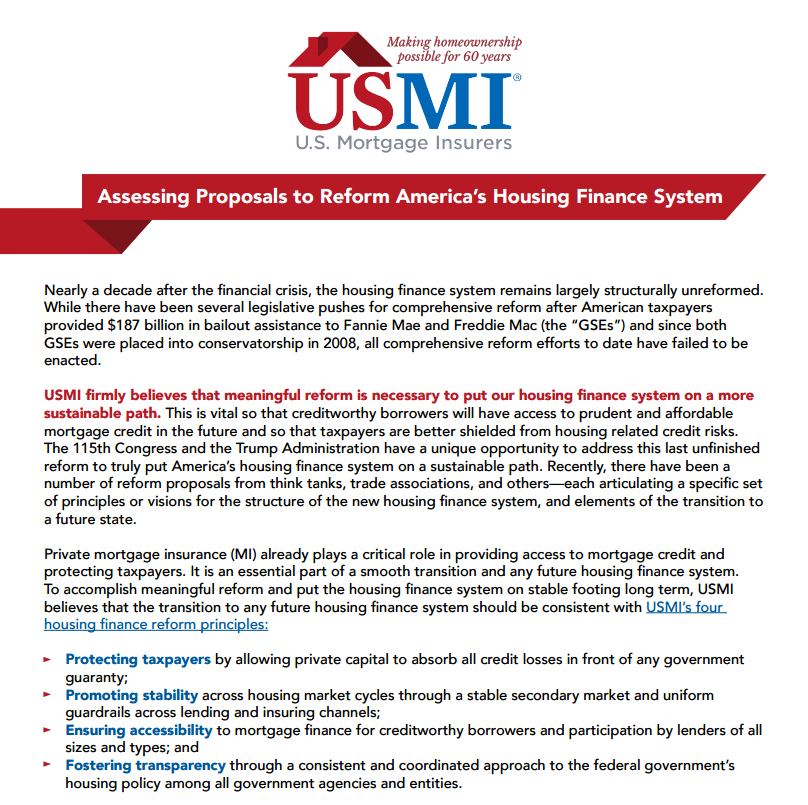By Lindsey Johnson
While discussing 2018 housing finance reform recently, specifically private mortgage insurance’s role in helping homebuyers and protecting lenders and the GSEs in the mortgage finance system, I was reminded of one of the most significant reasons MI is uniquely valuable: it is compatible with nearly every form of mortgage credit execution. While there are pilot projects underway at Fannie Mae and Freddie Mac experimenting with other forms of credit risk transfer (“CRT”), private mortgage insurance is the original form of CRT. MI is credit enhancement for borrowers with a low-down payment, and it has been a sustainable component of America’s housing finance system for more than 60 years.
Proposals and recommendations to reform the GSEs are being floated by government agencies and lawmakers, financial experts, academics, think tanks, and housing organizations. While these proposals seek the same goal of achieving much needed reform, there are many different ideas for what reform should achieve.
For more than six decades, private mortgage insurance has played a critical role in helping first time buyers—especially those without a large down payment—achieve affordable home financing while also protecting lenders (and the government and taxpayers when these mortgages are securitized by Fannie Mae and Freddie Mac). MI should continue to provide this important function in the housing system of tomorrow.
But more than being compatible, the timing of mortgage insurance matters too. When we talk about “loan level” or “front-end” or “at origination” credit enhancement we are specifically referring to how MI is part of a low-down payment mortgage from day one. When a homebuyer sits down at the settlement table to sign paperwork and get their keys, the mortgage is insured. Just like you are required to have auto insurance before you drive your car, the protection on these mortgages is present before the homebuyer moves in. Mortgage insurance is part of a low-down payment conventional mortgage if the loan is held on a bank’s portfolio for a period of time or whether it is pooled with others and securitized by Fannie Mae or Freddie Mac—the protection on the individual loan remains present. And it’s a good thing, too, considering private mortgage insurers paid over $50 billion in claims through the down turn – losses the government and taxpayers didn’t have to bear. This is important because, while it is a positive step for the GSEs to experiment with other forms of CRT in the system, these new alternatives are not the same and shouldn’t be considered interchangeable.
Many of the benefits of MI come from the fact that it attaches to the loan at the time the loan is originated, something that should occur in any future system for the reasons discussed below.
What are the unique benefits of MI?
- Loan-level insurance is a form of credit enhancement that most aligns with borrowers, servicers, and investors to not only put borrowers into homes, but also to keep them there. MI is unique because it actively manages credit risk, reducing risk on individual low-down payment loans while affording lenders flexibility for secondary market execution, whether through the GSEs, Federal Home Loan Bank System, private securitization, or to hold loans on portfolio. Being part of the loan from the time it is originated allows mortgage insurers to provide a second set of eyes when it comes to underwriting, helping to ensure the buyer can afford the mortgage. MIs have decades of experience and expertise in pricing and managing mortgage credit risk to balance affordability and risk sensitivity—something unique to MI that is not available through most other forms of credit enhancement. Because MIs are in the first-loss position (meaning they are the first to pay losses in a default after the borrower’s down payment)—MIs have the incentive to use strong underwriting, which strengthens the mortgage finance system. Also, unlike other CRT structures, because MI is done at the individual loan level, MIs have a strong incentive to help borrowers achieve a workout to stay in their home rather than to default.
- MI is compatible with different housing finance systems. MI protection travels with a home loan wherever it goes, including being added to a lender’s balance sheet, sold to an investor, or placed into a securitization pool. As a result, unlike with other CRT pilot programs, MI does not rely on the GSEs or other government or quasi-government entities to hold and distribute credit risk. Private MI is fully compatible with the broadly shared goal of a housing finance system with multiple funding sources and substantial private capital—a feature that distinguishes MI from other forms of credit enhancement.
- Private MI can transition smoothly across the housing finance system. While the other CRT pilots were built to operate only within the Fannie Mae and Freddie Mac construct, the MI industry has historically adapted as the mortgage finance system evolved—from the dominance of Savings & Loan associations to the growth of the GSEs and independent mortgage bankers. The MI industry has the continued ability to evolve and serve any new system that is created with virtually no disruption to the origination and servicing of mortgage loans.
Understanding that our options for a reformed housing finance system is not constrained to a single model, and that a permanent source of private capital can be available under these different constructs, allows policymakers and stakeholders to examine the best system for addressing the concerns/flaws that exist today and how to make a more effective and efficient system in the future. Since 1957, the MI industry has helped more than 25 million families become homeowners while protecting the taxpayers and the federal government from mortgage credit risk. MI will continue to promote homeownership and taxpayer protection in a new housing finance system.











